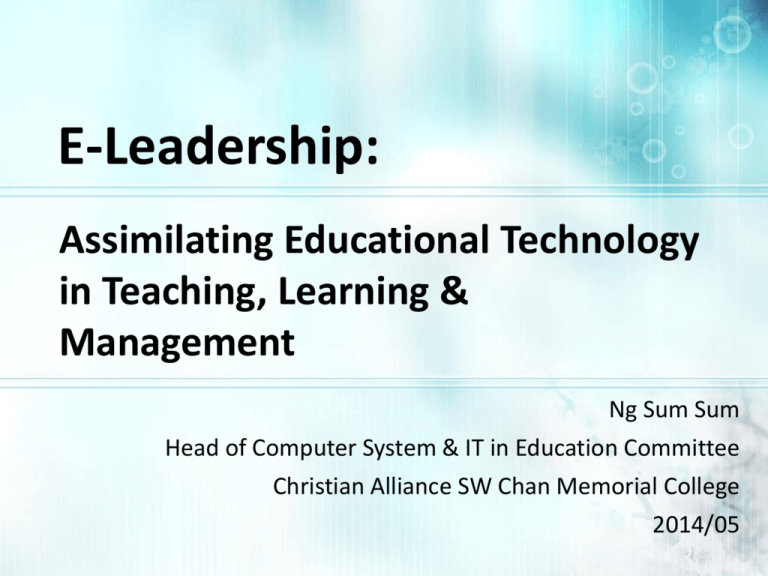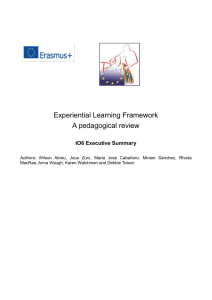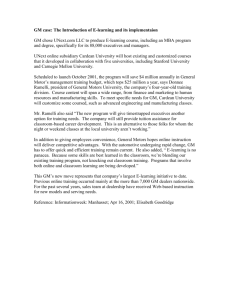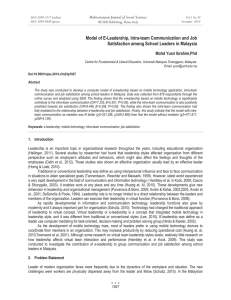Presentation slides
advertisement

E-Leadership: Assimilating Educational Technology in Teaching, Learning & Management Ng Sum Sum Head of Computer System & IT in Education Committee Christian Alliance SW Chan Memorial College 2014/05 Why "Technology Adoption" in classroom? Benefits of Technology Adoption: • offer students new instructional and learning experiences; • promote deep processing of ideas; • increase students interaction with subject matter; • provide students with significantly expanded learning opportunities; • equip students to independently organize their learning process; : • links with increased level of academic achievement. Kurt, Serhat. (2013). Creating Technology-Enriched Classrooms: Implementation Challenges in Turkish Education. Learning, Media and Technology, 39(1), 90 – 106. How can we use Technology to TRANSFORM Learning? • Guiding Principle • Blooms Taxonomy • SMAR Model • Technological Pedagogical Content Knowledge (TPACK) Framework The Guiding Principle Blooms Taxonomy (Revised Digital Version) High level thinking skill Putting information together in an innovative way Making judgment based on a set of guidelines Breaking concept into parts & understand how each parts is related to one another Use the knowledge gained in new way Making sense of what you have learnt Recalling relevant knowledge from long term memory Low level thinking skill Based on APA adaption of Anderson, L. W. & Krathwohl, D.R. (Source: http://www.apa.org) Blooms Taxonomy (Revised Digital Version) Direct a video or podcase Moderate a forum, blog response & apps beta testing Create web application & leverage Google Docs Playing educational games, editing wiki and sharing photos online Blog journaling, commenting on websites Use of social bookmark, search engines & social networking SMAR Model SMAR model shows a progression that adopters of educational technology often follow as they progress through teaching and learning with technology. SMAR Model Explained for Teachers. Educational Technology and Mobile Learning. (Ref: http://www.educatorstechnology.com/2013/06/samr-model-explained-forteachers.html) SMAR Model Level Definition Examples Functional Change Substitution Computer technology is used to perform the same task as was done before the use of computers. Students print out worksheet, finish it, pass it in. No functional change in teaching and learning. Augmentation Computer Technology offers an effective tool to perform common tasks. Students take a quiz using an online Google Form in stead of using pencil and paper. There is some functional benefit here in that paper is being saved, students and teacher can receive almost immediate feedback on student level of understanding of material. Modification Common classroom tasks are being accomplished through the use of computer technology. Students are asked to write an essay around the theme "And This I Believe...". An audio recording of the essay is made along with an original musical soundtrack. The recording will be played in front of an authentic audience such as parents, or college admission counselors. Computer technology is necessary for this classroom to function allowing peer and teacher feedback, easy rewriting, and audio recording. Questions about writing skills increasingly come from the students themselves. Redefintion Computer technology allows for new tasks that were previously. A classroom is asked to create a documentary video answering an essential question related to important concepts. Teams of students take on different subtopics and collaborate to create one final product. Teams are expected to contact outside sources for information. At this level, common classroom tasks and computer technology exist not as ends but as supports for student centered learning. Collaboration becomes necessary and technology allows such communications to occur. Questions and discussion are increasingly student generated. SMAR Model (iPad Version) A Wonderful Visual on How to use SMAR Model on Different Classroom Tasks. Educational Technology and Mobile Learning. (Ref: http://www.educatorstechnology.com/ 2014/02/awonderful-visual-on-how-to-use-samr.html ) Technological Pedagogical Content Knowledge (TPACK) Framework Effective technology integration for pedagogy around specific subject matter requires developing sensitivity to the dynamic, transactional relationship between these components of knowledge situated in unique contexts. There is no “one best way” to integrate technology into curriculum. Integration efforts should be creatively designed or structured for particular subject matter ideas in specific classroom contexts. Mishra & Koehler (2006). Technological pedagogical content knowledge: A framework for teacher knowledge. Teachers College Record, 108(6), 1017-1054. Components of 21st Century Classroom Source: http://www.wiredacademic.com/2012/07/infographic-components-of-a-21st-century-classroom/ Components of 21st Century Classroom Source: http://www.wiredacademic.com/2012/07/infographic-components-of-a-21st-century-classroom/ Components of 21st Century Classroom Source: http://www.wiredacademic.com/2012/07/infographic-components-of-a-21st-century-classroom/ Components of 21st Century Classroom Source: http://www.wiredacademic.com/2012/07/infographic-components-of-a-21st-century-classroom/ Components of 21st Century Classroom How Innovation is Implemented? Models of Educational Technology Implementation Avidov-Ungar, O. (2011). "Islands of Innovation" or "Comprehensive Innovation", Assimilating Educational Technology in Teaching, Learning & Management: A Case Study of School Networks in Israel. Interdisciplinary Journal of E-Learning & Learning Objects, 6, 259 – 280. Models of Educational Technology Implementation Comprehensive Innovation • It permeates all levels of organization; • It creates a new organization culture which affect values and basic assumptions in organization; • It derives from the assumption that a successful implementation of innovation requires a radical change in the organization’s basic assumptions and the formulation of new organizational paradigms and perspectives. Models of Educational Technology Implementation Islands of Innovation • It is implemented in form of pilot project; • It usually leads to first degree changes which mainly involve changes in the characteristics and behaviors of the organization, without a significant change in the organization’s culture, norms & basic assumption; • It is assumed the success of the islands will serve as a role model, slowly dissipate to the rest of the organization and finally lead to a comprehensive innovation. Models of Educational Technology Implementation Islands of Innovation • It is preferred strategy for education system because – it uses up only a small portion of resources; – it is less threatening to organization’s overall values and basic assumption; – it does not adversely impact the existing hierarchies of organization; – it minimizes the damage of lost; – it is assumed will, in turn, create a ripple effect leading to comprehensive innovation. Models of Educational Technology Implementation Success of Islands of Innovation • does not accomplished by a change in values and perspectives of teachers* towards technological pedagogy; • does not generated a new organizational culture, particular in the field of pedagogy; • does not confident teachers* to commit innovation; • has chance to create a buffering effect impede the transfer of innovation from island to the rest of organization. * Teachers who were not involved in islands of innovation Orit Avidov-Ungar and Yoram Eshet-Alkakay. (2011). The Islands of Innovation Model: Opportunities and Threats for Effective Implementation of Technological Innovation in the Education System Issues in Informing Science and Information Technology, 8, 363 - 376. What should "Technological Leader" do? E-Leadership refers to the ability of a person to influence the behavior of others in a digital technology-mediated environment in order to achieve common goal (traditional approach). Appropriate strategic action to promote consensus regarding shared values and to allocate necessary resources which enable the creation of new culture of comprehensive innovation. What should "Technological Leader" do? Factors interfering with technological integration identified by a number of researches (2005 – 2011) : • Beliefs about the role of technology in education; • Fundamental disjunction between traditional teaching approaches and technology-enhanced teaching methods; • Lack of availability of technology tools; • Lack of adequate technological training for teachers. Kurt, Serhat. (2013). Creating Technology-Enriched Classrooms: Implementation Challenges in Turkish Education. Learning, Media and Technology, 39(1), 90 – 106. 陳朱素華校本經驗 Barriers • Beliefs about the role of technology in education; 推行措施 • Fundamental disjunction between traditional teaching approaches and technology-enhanced teaching methods. • 搜集成功資訊科技教學案例向不同 學科分享; • 與科任老師一同設計課堂教學,讓 科任老師明白 IT 在課堂活動中適當 的位置及教學功能; • 鼓勵同工多參與教育局舉辦有關IT 教學培訓課程。 • 由專責同工負責推動IT教學; • 定期向全體老師報告IT教學新趨勢, 目的營建一個整體「 IT教學」的文 化; • 與各科協商,推行IT教學的時間表。 陳朱素華校本經驗 Barriers • Lack of availability of technology tools; 推行措施 • Lack of adequate technological training for teachers. • 向老師及學生提供使用IT教學活動 • 安排需用IT設備及適合課堂活動用 Apps; 所需的培訓; • 邀請老師出席校內IT教學觀課活動; • 提供科任老師在真實IT課堂教學時 的支援,目的在加強教師的信心, 將失敗的機會減至最低。 陳朱素華校本經驗 來自兩方面的專家 共同建構 來自電子學習 統籌主任、 電腦科老師 來自科主任、 科任老師 How do your school use ICTs? e-Learning Planning Framework Ministry of Education, New Zealand What is the e-learning planning framework? Why is it important? How was it developed? What’s in it for you? Download site: http://www.ncte.ie/elearningplan/handbook/ Source: http://www.ncte.ie/elearningplan/handbook/ e-Learning Planning Framework What – and who - is it for? • Principals and e-learning leaders (organisational) • Teachers (individual) • Professional development facilitators The primary purpose is • a planning tool • to provide a 'road map' to review how well they use ICTs to support learning for the purpose of finding out where they are, and what they need to do next. e-Learning Planning Cycle Source: http://www.ncte.ie/media/ENG_Getting_started.pdf e-Learning Roadmap • Provides the school with a snapshot of its strengths and challenges in relation to e-Learning and allows the school to identify priorities for progression to the next stage. • 5 key areas: – Leadership and planning – ICT in the curriculum – Professional development – e-Learning culture – ICT infrastructure Source: http://www.ncte.ie/elearningplan/roadmap/ • 4 stages of development: – Initial – e-Enabled – e-Confident – e-Mature e-Learning Roadmap Leadership and planning (example) Source: http://www.ncte.ie/media/Leadership_and_Planning_area.pdf 21st Century e-Leadership e-Leadership is defined as the usage of a school management information system, not just only educational technology, for exchanging updated pedagogical data in order to increase school effectiveness through data- based decision making and instant interactions among different stakeholders. Blau, I & Presser, O. (2013). e-Leadership of School Principals: Increasing School Effectiveness by a School Management Information System. British Journal of Educational Technology, 44(6), 1000 – 1011. School Management Information System • School MIS emphasize organizational aspects and the transfer of pedagogical information, such as curriculum performance and student activity and achievement. • Each member of the organization receives access to the data according to his or her position. • e-Leadership by school principals is empowered by providing extensive on-demand up-to date data at different levels and enabling data-based pedagogical decisions. Conclusion E-Leadership refers to • the ability of a person to influence the behavior of others in a digital technology-mediated environment in order to achieve technological adoption in pedagogy; • the usage of a school management information system for exchanging updated pedagogical data in order to increase school effectiveness. Support Service to IT in Education Education Bureau IT in Education Section Centre of Excellence (CoEs) http://www.edb.gov.hk/en/edusystem/primary-secondary/applicable-toprimary-secondary/it-in-edu/coes.html Thank You





